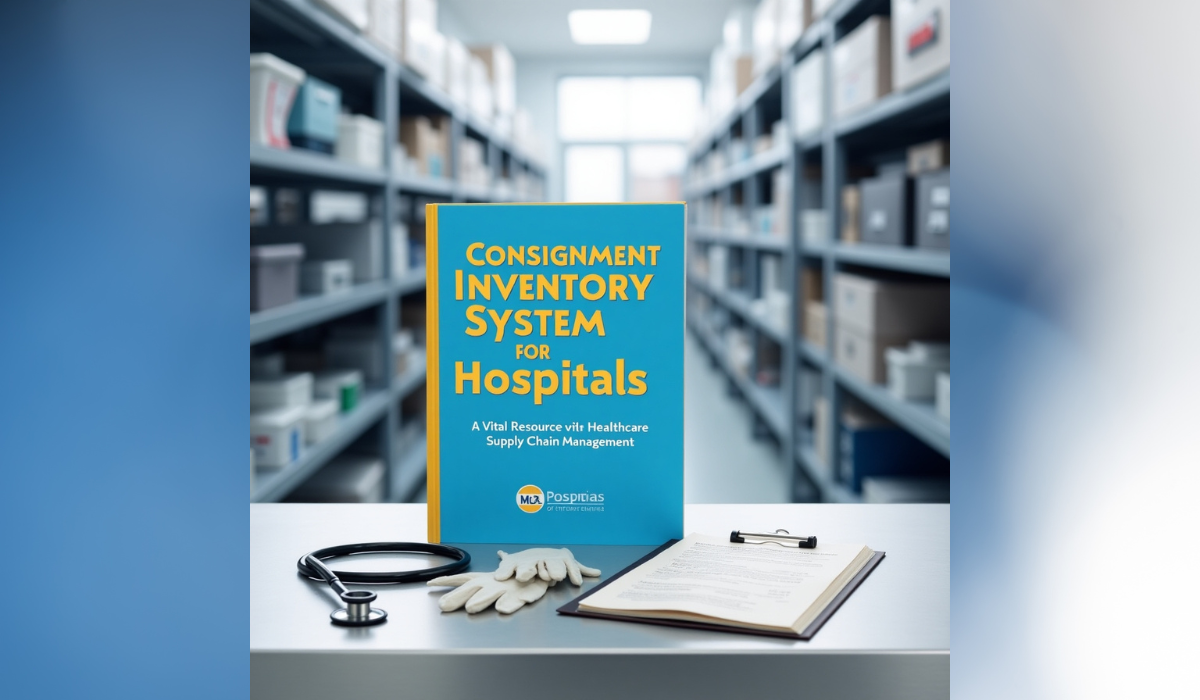Blog
A Book on Consignment Inventory System for Hospitals: A Vital Resource for Healthcare Supply Chain Management

Hospitals play a pivotal role in providing quality healthcare, and a critical component of their success lies in their ability to manage medical supplies efficiently. One such effective strategy for managing hospital inventory is using a consignment inventory system. This system can improve supply chain efficiency, reduce costs, and ensure hospitals have timely access to essential products. In this article, we will explore the ins and outs of consignment inventory systems, how they work in hospitals, and the benefits they provide.
What is a Consignment Inventory System in Hospitals?
A consignment inventory system is a supply chain strategy where vendors supply medical products but remain the supplier’s property until used in the hospital. In this arrangement, the hospital only pays for the items when consumed instead of purchasing the inventory outright. This system helps hospitals maintain lower upfront costs while ensuring that they never run out of critical supplies.
In the healthcare industry, where the demand for specific medical supplies is unpredictable, a consignment inventory system provides the flexibility to manage high-cost items such as medical devices, pharmaceuticals, and surgical instruments without the burden of purchasing inventory in advance.
Why Should Hospitals Consider a Consignment Inventory System?
Implementing a consignment inventory system can offer several significant benefits to hospitals. These include:
1. Improved Cash Flow
Since hospitals only pay for products when they are used, they can maintain healthier cash flow, particularly for high-cost items. This arrangement reduces the need for significant upfront investments in inventory, freeing up funds for other operational needs.
2. Reduced Inventory Holding Costs
Storing excess inventory can be expensive, particularly in healthcare settings where space is limited. A consignment inventory system allows hospitals to minimize their inventory holding costs by keeping only the products needed on-site while the supplier maintains the rest in their warehouse.
3. Efficient Supply Chain Management
Managing a hospital’s inventory is a complex process. A consignment inventory system helps hospitals maintain just the right amount of inventory by allowing suppliers to monitor stock levels and automatically replenish items as needed. This ensures that the hospital has continuous access to supplies without overstocking.
4. Risk Mitigation
Medical supplies and devices have a limited shelf life, and buying large quantities upfront can lead to waste if items become obsolete or expired before being used. A consignment inventory system helps mitigate this risk by reducing the hospital’s inventory exposure and ensuring that only the most in-demand supplies are stocked.
5. Streamlined Ordering Process
The consignment model often includes integrated technology solutions that help streamline the ordering process. Hospitals can automatically reorder supplies when levels fall below a certain threshold, which reduces the risk of stockouts or overordering.
Key Components of a Consignment Inventory System in Hospitals
A consignment inventory system in hospitals typically includes several key components that enable its effective operation. These include:
1. Real-time Inventory Management Software
Advanced inventory management software is vital in tracking stock levels, usage, and ordering patterns. Real-time monitoring ensures accurate inventory records, helping hospital staff know when to reorder supplies and avoid running out of critical items.
2. Barcoding and RFID Technology
Hospitals often employ barcoding or RFID (Radio Frequency Identification) technology to optimize the consignment inventory system. These technologies allow for easy tracking of medical supplies as they are used and help prevent inventory errors.
3. Vendor Relationship Management
Consignment inventory systems require a strong partnership between the hospital and suppliers. Communication and data sharing are essential to ensure timely replenishment and alignment of inventory levels with hospital needs.
4. Payment Terms and Reporting
Detailed reports on inventory usage and payment tracking are crucial to a consignment inventory system. Hospitals must ensure the system is set up with clear payment terms, including invoicing for used products and regular audits to maintain transparency.
Advantages of Consignment Inventory Systems in Hospitals
Implementing a consignment inventory system in hospitals offers several advantages that make it an attractive option for healthcare supply chain management:
- Lower Operational Costs: The consignment model reduces procurement and storage costs, allowing hospitals to use their budgets more efficiently and pass savings to patients.
- Enhanced Inventory Accuracy: Hospitals benefit from more accurate inventory records by allowing suppliers to manage inventory levels, reducing human error and inventory discrepancies.
- Optimized Stock Levels: With automated inventory management, hospitals can maintain optimal stock levels of supplies. The right amount of stock can be available without the risk of understocking or overstocking.
- Focus on Patient Care: By freeing hospital staff from managing extensive inventories of supplies, consignment systems allow them to focus on what matters most—providing high-quality care to patients.
Best Practices for Managing Consignment Inventory in Hospitals
To successfully implement a consignment inventory system, hospitals must adhere to several best practices to ensure maximum efficiency:
1. Clear Communication with Vendors
Establish strong communication channels with vendors to ensure supply replenishment and product tracking are handled smoothly. This will also help in managing product recalls and supply disruptions.
2. Regular Inventory Audits
Even though the supplier is responsible for inventory, hospitals should regularly audit inventory levels and usage to ensure accuracy and detect discrepancies early on.
3. Integration with Electronic Health Records (EHR) Systems
Integrating consignment inventory systems with the hospital’s EHR system helps streamline the ordering process and ensures that the necessary supplies are ordered when needed for patient care.
4. Training for Hospital Staff
Educate hospital staff on how to use inventory management software and best practices for managing consignment supplies. This will minimize errors and improve efficiency.
5. Monitor Expiry Dates
Regularly check expiry dates and rotate stock to ensure products are used before expiration. Consignment models help with this, as the vendor often handles the turnover process.
Conclusion: Revolutionizing Hospital Inventory Management with Consignment Systems
Incorporating a consignment inventory system in hospitals is an innovative and effective way to optimize the management of medical supplies, reduce costs, and ensure a smooth supply chain operation. By minimizing upfront costs, streamlining ordering processes, and improving cash flow, hospitals can focus more on delivering high-quality patient care rather than worrying about inventory management.
For hospitals looking to implement a consignment inventory system, adopting modern technologies like inventory management software and RFID tracking will help streamline processes and improve supply chain efficiency. A well-implemented consignment system can improve patient outcomes by ensuring timely access to critical medical supplies without unnecessary financial strain.
FAQs About A Book on Consignment Inventory System for Hospitals
Q1: How do hospitals keep track of inventory?
Hospitals track inventory using inventory management software, which may be integrated with barcode scanning or RFID technology. This software updates stock levels in real time, generates reordering alerts, and ensures accurate tracking of medical supplies.
Q2: What is the consignment inventory method?
The consignment inventory method is when a hospital receives medical supplies from a supplier but only pays for them when they are used, not at the time of delivery. The supplier retains ownership of the items until they are consumed.
Q3: What is the inventory system in a hospital?
A hospital inventory system manages medical supplies, equipment, and pharmaceuticals. It involves tracking stock levels, reordering supplies, and using inventory management software to maintain efficient and accurate records.
Q4: How does consignment work in healthcare?
In healthcare, consignment means the hospital receives supplies from a supplier but only pays for what is used. The supplier retains ownership until the items are consumed in patient care.
